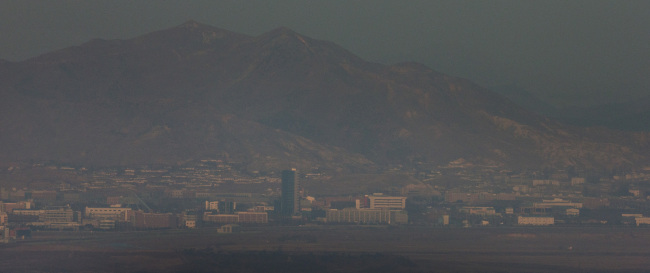North Korea on Thursday announced it would nullify all inter-Korea relations and dispose of all assets left behind by South Korean companies, dealing yet another blow to already precarious inter-Korea relations.
The announcement came two days after Seoul declared a set of unilateral sanctions on the communist country, after the U.N. passed what officials have called the strongest sanctions in decades last week.
 |
| The joint inter-Korean factory complex in Gaeseong, North Korea is seen in this photo taken Thursday. (Yonhap) |
It also came on the heels of intensified military tensions after Pyongyang fired two short-range ballistic missiles into the East Sea earlier in the day.
“As of this point, we declare all agreements related to economic cooperation and exchange between the Koreas to be void,” said the spokesman for the North’s Committee for the Peaceful Reunification of Korea.
It added that further “special measures” to inflict political, military and economic damage upon President Park Geun-hye’s administration would take place, denouncing the unilateral sanctions announced Tuesday as “useless and absurd.”
Pyongyang had taken similar actions on a smaller scale in 2008 when it scrapped a Mount Geumgangsan tourism joint project with Seoul’s Hyundai Asan company and seized the firm’s properties in its territory.
Seoul’s Unification Ministry said it strongly condemned the move, calling it “provocation that cannot be tolerated at any rate.”
“Our (Seoul’s) unilateral damage is a just measure for North Korea conducting a nuclear testing and a long-range missile launch, despite warnings from us and the international society. North Korea must not inflict damage upon our citizens’ valuable assets, and it will be held responsible upon failure to comply,” said Unification Ministry spokesman Jeong Joon-hee.
Pyongyang’s bridge-burning gesture on Thursday took place a month after Seoul pulled out of the joint industrial park in Gaeseong, to which the North responded by expelling South Koreans at the factory, freezing assets and declaring it a military-controlled area.
Seoul’s Unification Ministry claimed to have evidence that the Kim Jong-un regime had siphoned out the majority of its investments in the compound, but declined to reveal the evidence.
An association representing the 120 firms operating factories in the complex said on Feb. 24 that the accumulated loss for the firms in terms of assets and inventory was 815.2 billion won ($678 million) at that point. A 160-day suspension in 2013 had resulted in approximately a trillion won in damage to the South Korean firms.
The inter-Korea relationship had been spiraling downward since the North started off the year with a nuclear test on Jan. 6 and a long-range rocket launch on Feb. 7, violating the existing U.N. ban on developing ballistic missile and nuclear programs.
Pyongyang at around 5:20 a.m. shot two short-range ballistic missiles into the East Sea, which South Korea’s military presumed to be Scud missiles. The North’s arsenal is believed to have several Scud B and Scud C missiles, which have ranges of 300 kilometers and 550 kilometers, respectively.
The missiles were fired from North Hwanghae Province and flew approximately 500 kilometers, according to the Joint Chiefs of Staff.
“The military is keeping close track of the related situations, and is preparing for the North’s provocations,” it said.
Last week, Pyongyang held a test-firing of its new 300-milimeter-caliber multiple-rocket launch system.
In addition to sanctions, North Korea has voiced complaints over the joint Seoul-Washington military drills, which officials said will focus on striking down its leadership.
Kim claimed that his troops already have the capacity to miniaturize a nuclear warhead to mount onto a ballistic missile, and the state media on Wednesday released photos of what was believed to be the device. South Korea and the U.S. dismissed its statement, saying that such claims have not been verified yet.
An unnamed military official told media that the device in the photo is likely to be a model, as Kim was seen smoking in front of it in one of the photos. London-based institute IHS Jane’s said that the model is unlikely to be a thermonuclear weapon, as Pyongyang has claimed, based on its shape. A thermonuclear bomb would take a more oblong-like structure.
Observers have predicted that there is high probability of minor skirmishes occurring around the inter-Korea borders.
Omar Hamid, the head of Asia analysis at IHS Country Risk, said that the North is likely to think its self-proclaimed “nuclear deterrent” will give it more leeway to use conventional weapons designed to exert political pressure on South Korea and the United States.”
Stepping up vigilance against the North, South Korea reportedly deployed its medium-range surface-to-air missile — KM-SAM or Cheongung — in its northwestern regions near inter-Korea borders, against North Korean air threats.
By Yoon Min-sik
(minsikyoon@heraldcorp.com)
(Related content on Page 3)

